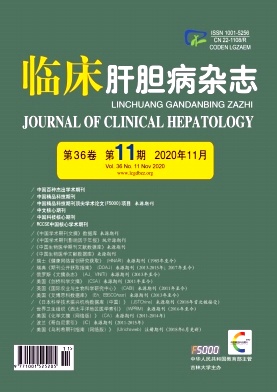|
[1] MINDIKOGLU AL,PAPPAS SC. New developments in hepatorenal syndrome[J]. Clin Gastroenterol Hepatol,2018,16(2):162-177. e1.
|
|
[2] FACCIORUSSO A. Hepatorenal syndrome type 1:Current challenges and future prospects[J]. Ther Clin Risk Manag,2019,15:1383-1391.
|
|
[3] SRIVASTAVA S,SHALIMAR,VISHNUBHATLA S,et al. Randomized controlled trial comparing the efficacy of terlipressin and albumin with a combination of concurrent dopamine,furosemide,and albumin in hepatorenal syndrome[J]. J Clin Exp Hepatol,2015,5(4):276-285.
|
|
[4] WAN SQ,WAN XF,ZHU QJ,et al. A comparative study of high-or low-dose terlipressin therapy in patients with cirrhosis and type 1 hepatorenal syndrome[J]. Chin J Hepatol,2014,22(5):349-353.(in Chinese)万十千,万学发,朱清静,等.高低剂量特利加压素治疗肝硬化合并1型肝肾综合征的比较研究[J].中华肝脏病杂志,2014,22(5):349-353.
|
|
[5] CAVALLIN M,PIANO S,ROMANO A,et al. Terlipressin given by continuous intravenous infusion versus intravenous boluses in the treatment of hepatorenal syndrome:A randomized controlled study[J]. Hepatology,2016,63(3):983-992.
|
|
[6] KULKARNI AV,KUMAR P,RAO NP,et al. Terlipressin-induced ischaemic skin necrosis[J]. BMJ Case Rep,2020,13(1):e233089.
|
|
[7] ALLEGRETTI AS,ISRAELSEN M,KRAG A,et al. Terlipressin versus placebo or no intervention for people with cirrhosis and hepatorenal syndrome[J]. Cochrane Database Syst Rev,2017,6:CD005162.
|
|
[8] MOORE K,JAMIL K,VERLEGER K,et al. Real-world treatment patterns and outcomes using terlipressin in 203 patients with the hepatorenal syndrome[J]. Aliment Pharmacol Ther,2020,52(2):351-358.
|
|
[9] RODRIGUEZ E,ELIA C,SOLAE,et al. Terlipressin and albumin for type-1 hepatorenal syndrome associated with sepsis[J]. J Hepatol,2014,60(5):955-961.
|
|
[10] ABDEL-RAZIK A,MOUSA N,ABDELSALAM M,et al. Endothelin-1/nitric oxide ratio as a predictive factor of response to therapy with terlipressin and albumin in patients with type-1hepatorenal syndrome[J]. Front Pharmacol,2020,11:9.
|
|
[11] ANGELI P,GARCIA-TSAO G,NADIM MK,et al. News in pathophysiology,definition and classification of hepatorenal syndrome:A step beyond the International Club of Ascites(ICA)consensus document[J]. J Hepatol,2019,71(4):811-822.
|
|
[12] ISRAELSEN M,KRAG A,ALLEGRETTI AS,et al. Terlipressin versus other vasoactive drugs for hepatorenal syndrome[J].Cochrane Database Syst Rev,2017,9:CD011532.
|
|
[13] WANG L,LONG Y,LI KX,et al. Pharmacological treatment of hepatorenal syndrome:A network meta-analysis[J]. Gastroenterol Rep(Oxf),2020,8(2):111-118.
|
|
[14] CELIS P,RADA G. Noradrenaline or terlipressin for hepatorenal syndrome?[J]. Medwave,2015,15(Suppl 2):e6235.
|
|
[15] MATTOSAZ,MATTOS AA,RIBEIRO RA. Terlipressin versus noradrenaline in the treatment of hepatorenal syndrome:Systematic review with meta-analysis and ful economic evaluation[J]. Eur J Gastroenterol Hepatol,2016,28(3):345-351.
|
|
[16] ZHANG Z,MADDUKURI G,JAIPAUL N,et al. Role of renal replacement therapy in patients with type 1 hepatorenal syndrome receiving combination treatment of vasoconstrictor plus albumin[J]. J Crit Care,2015,30(5):969-974.
|
|
[17] PARK GC,HWANG S,JUNG DH,et al. Is renal replacement therapy necessary in deceased donor liver transplantation candidates with hepatorenal syndrome:A 2-year experience at a high-volume center[J]. Ann Surg Treat Res,2020,98(2):102-109.
|
|
[18] KADE G,LUBAS A,SPALENIAK S,et al. Application of the molecular adsorbent recirculating system in type 1 hepatorenal syndrome in the course of alcohol-related acute on chronic liver failure[J]. Med Sci Monit,2020,26:e923805.
|
|
[19] LAVAYSSIERE L,KALLAB S,CARDEAU-DESANGLES I,et al. Impact of molecular adsorbent recirculating system on renal recovery in type-1 hepatorenal syndrome patients with chronic liver failure[J]. J Gastroenterol Hepatol,2013,28(6):1019-1024.
|
|
[20] CHMIELEWSKI J,LEWANDOWSKI RJ,MADDUR H. Hepatorenal syndrome:Physiology,diagnosis and management[J].Semin Intervent Radiol,2018,35(3):194-197.
|
|
[21] SONG T,ROSSLE M,HE F,et al. Transjugular intrahepatic portosystemic shunt for hepatorenal syndrome:A systematic review and meta-analysis[J]. Dig Liver Dis,2018,50(4):323-330.
|
|
[22] CHARILAOU P,DEVANI K,PETROSYAN R,et al. Inpatient mortality benefit with transjugular intrahepatic portosystemic shunt for hospitalized hepatorenal syndrome patients[J]. Dig Dis Sci,2020.[Online ahead of print]
|
|
[23] TRIVEDI PS,BROWN MA,ROCHON PJ,et al. Gender disparity in inpatient mortality after transjugular intrahepatic portosystemic shunt creation in patients admitted with hepatorenal syndrome:A nationwide study[J]. J Am Coll Radiol,2020,17(2):231-237.
|
|
[24] UTAKO P,EMYOO T,ANOTHAISINTAWEE T,et al. Clinical outcomes after liver transplantation for hepatorenal syndrome:A systematic review and meta-analysis[J]. Biomed Res Int,2018,2018:5362810.
|
|
[25] OKAMURA Y,HATA K,INAMOTO O,et al. Influence of hepatorenal syndrome on outcome of living donor liver transplantation:A single-center experience in 357 patients[J]. Hepatol Res,2017,47(5):425-434.
|
|
[26] FORMICA RN,AEDER M,BOYLE G,et al. Simultaneous liverkidney allocation policy:A proposal to optimize appropriate utilization of scarce resources[J]. Am J Transplant,2016,16(3):758-766.
|
|
[27] TARIQ R,SINGAL AK. Management of hepatorenal syndrome:A review[J]. J Clin Transl Hepatol,2020,8(2):192-199.
|
|
[28] OJEDA-YUREN AS,CERDA-REYES E,HERRERO-MACEDA MR,et al. An integrated review of the hepatorenal syndrome[J]. Ann Hepatol,2020.[Online ahead of print]
|







 DownLoad:
DownLoad: